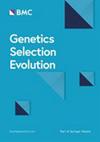Sequence-based GWAS reveals genes and variants associated with predicted methane emissions in French dairy cows
IF 3.1
1区 农林科学
Q1 AGRICULTURE, DAIRY & ANIMAL SCIENCE
引用次数: 0
Abstract
Due to their contribution to global warming, methane emissions from ruminants have been the subject of considerable scientific interest. It has been proposed that such emissions might be reduced using genetic selection; proposed phenotypes differ in the measurement methods used (direct or predicted methane emissions) and in the unit under consideration (g/d, g/kg of milk, g/kg of intake, residual methane emissions). Identifying the quantitative trait loci (QTLs) and candidate genes responsible for genetic variation in methane emissions allows a better understanding of the underlying genetic architecture of these phenotypes. Therefore, the aim of this study was to identify the genomic regions associated with six methane traits predicted from milk mid-infrared (MIR) spectra (0.33 ≤ R2 ≤ 0.88) in French Holstein dairy cows using genome-wide association studies at the whole-genome-sequence level. Six methane emission traits—in g/d, in g/kg of fat- and protein-corrected milk, and in g/kg of dry matter intake—were predicted from milk MIR spectra routinely collected by French milk recording companies. A genome-wide association study of the predicted methane emissions of 40,609 primiparous Holstein cows was conducted using imputed whole-genome-sequence data. This analysis revealed 57 genomic regions of interest; between 1 and 8 QTLs were identified on each of the autosomes except 4, 12, 21, 24 and 26. We identified multiple genomic regions that were shared by two or more predicted methane traits, illustrating their common genetic basis. Functional annotation revealed potential candidate genes, in particular FASN, DGAT1, ACSS2, and KCNIP4, which could be involved in biological pathways possibly related to methane production. The methane traits studied here, which were predicted from milk MIR spectra, appear to be highly polygenic. Several genomic regions associated with these traits contain candidate genes previously associated with milk traits. Functional annotation and comparisons with studies using direct methane measurements support some potential candidate genes involved in biological pathways related to methane production. However, the overlap with genes influencing milk traits highlights the challenge of distinguishing whether these regions genuinely influence methane emissions or reflect the use of milk MIR spectra to predict the phenotypes.基于序列的GWAS揭示了与法国奶牛预测的甲烷排放相关的基因和变异
由于它们对全球变暖的贡献,反刍动物的甲烷排放一直是科学界非常感兴趣的主题。有人提出,这种排放可以通过遗传选择来减少;所提出的表型在使用的测量方法(直接或预测的甲烷排放量)和考虑的单位(g/d, g/kg牛奶,g/kg摄入量,剩余甲烷排放量)上有所不同。确定甲烷排放遗传变异的数量性状位点(qtl)和候选基因可以更好地理解这些表型的潜在遗传结构。因此,本研究旨在通过全基因组序列水平的全基因组关联研究,确定与法国荷斯坦奶牛牛奶中红外(MIR)光谱(0.33≤R2≤0.88)预测的6个甲烷性状相关的基因组区域。根据法国牛奶记录公司常规收集的牛奶MIR光谱,预测了六种甲烷排放特征——g/d, g/kg脂肪和蛋白质校正牛奶,g/kg干物质摄入量。利用估算的全基因组序列数据,对40609头荷斯坦奶牛的预测甲烷排放量进行了全基因组关联研究。该分析揭示了57个感兴趣的基因组区域;除4、12、21、24和26个常染色体外,其余常染色体上均鉴定出1 ~ 8个qtl。我们发现了两个或更多预测甲烷特征共享的多个基因组区域,说明了它们共同的遗传基础。功能注释揭示了潜在的候选基因,特别是FASN, DGAT1, ACSS2和KCNIP4,它们可能参与可能与甲烷产生相关的生物学途径。本文研究的甲烷性状,由牛奶MIR光谱预测,似乎是高度多基因的。与这些性状相关的几个基因组区域包含先前与乳性状相关的候选基因。功能注释和与使用直接甲烷测量的研究的比较支持一些潜在的候选基因参与与甲烷产生相关的生物学途径。然而,与影响牛奶性状的基因的重叠突出了区分这些区域是否真正影响甲烷排放或反映使用牛奶MIR光谱预测表型的挑战。
本文章由计算机程序翻译,如有差异,请以英文原文为准。
求助全文
约1分钟内获得全文
求助全文
来源期刊

Genetics Selection Evolution
生物-奶制品与动物科学
CiteScore
6.50
自引率
9.80%
发文量
74
审稿时长
1 months
期刊介绍:
Genetics Selection Evolution invites basic, applied and methodological content that will aid the current understanding and the utilization of genetic variability in domestic animal species. Although the focus is on domestic animal species, research on other species is invited if it contributes to the understanding of the use of genetic variability in domestic animals. Genetics Selection Evolution publishes results from all levels of study, from the gene to the quantitative trait, from the individual to the population, the breed or the species. Contributions concerning both the biological approach, from molecular genetics to quantitative genetics, as well as the mathematical approach, from population genetics to statistics, are welcome. Specific areas of interest include but are not limited to: gene and QTL identification, mapping and characterization, analysis of new phenotypes, high-throughput SNP data analysis, functional genomics, cytogenetics, genetic diversity of populations and breeds, genetic evaluation, applied and experimental selection, genomic selection, selection efficiency, and statistical methodology for the genetic analysis of phenotypes with quantitative and mixed inheritance.
 求助内容:
求助内容: 应助结果提醒方式:
应助结果提醒方式:


